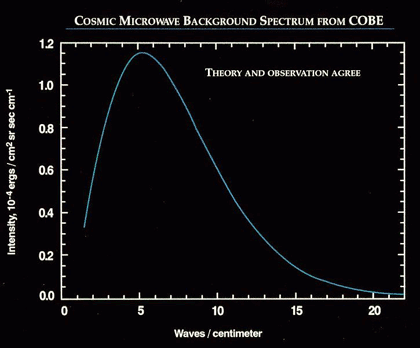
CMB
Image: The spectrum of the cosmic microwave background as measured by the COBE satellite, in agreement with a black-body spectrum. The measurement uncertainties are smaller than the width of the curve.
The cosmic microwave background (CMB) can be thought of as the “afterglow” of the Big Bang. In the first few hundred thousand years, the universe is filled with a hot plasma of photons, protons, electrons, and nucleons formed during Big-Bang nucleosynthesis, along with other unstable baryons. But as space expanded, the plasma cooled, until it reached a temperature when stable hydrogen atoms could be formed. At this point, with most of the plasma converted to electrically-neutral hydrogen gas, radiation traveled freely: the universe becomes transparent – the start of the Dark Ages. This radiation was subsequently red-shifted as space expanded, and now predominantly consists of microwaves.
Since the plasma at this time of recombination had a purely thermal distribution, and an almost perfectly uniform temperature, the radiation released was that of an almost perfect black body. More recently, however, it has been found to have an anisotropic structure, the subject of intense observational and theoretical investigation.
The CMB was discovered by Penzias and Wilson in 1964, who were rewarded with the 1978 Nobel Prize.
Links
Robert Wilson, Nobel Prize lecture, 1978, ‘The cosmic microwave background’ >
Multimedia
Matt Johnson: Introduction to the Cosmic Microwave Background and what it tells us >


